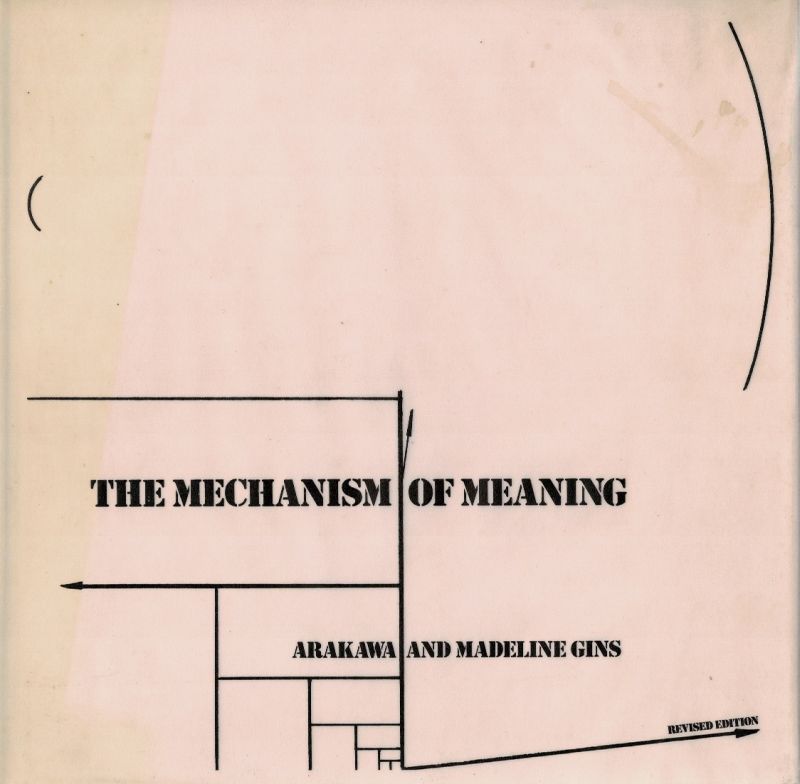Arakawa and Madeleine Gins. The Mechanism of Meaning.
The Mechanism of Meaning.
Revised Edition. New York, Abbeville Press, 1988. Quarto (29 cm wide x 29 cm high). 161 pages (including six translucent pages at the rear) and the two often missing, loosely inserted cards which show a reproduction of a micrograph of zirconium from the Atomic Resolution Microscope at the Lawrence Berkeley Laboratory, University of California. Original Hardcover with illustrated dustjacket. Minor staining to dustjacket. Otherwise in very good condition with only minor signs of wear.
The Mechanism of Meaning (1960s – 1980s)
Beginning in 1963, he collaborated with fellow artist, architect, and poet Madeline Gins on the research project The Mechanism of Meaning, which was completed by 1973. This research project and its subsequent architectural projects – both built and unbuilt ones – formed the basis of the 1997 Arakawa + Gins: Reversible Destiny exhibition at the Guggenheim Museum SoHo (the accompanying book of the same title remains the most comprehensive collection of their work, and it incorporates the whole of the Arakawa/Gins book, The Mechanism of Meaning).
The panels appear as a constellation of views concerning the nature of meaning that may be characterized as “holistic” or as entailments of a holistic view concerning meaning. To date, two editions of The Mechanism of Meaning have been made and many of the panels fuse collaged elements.
In the years since Arakawa’s and Gins’s deaths, there has been a legal dispute regarding ownership of The Mechanism of Meaning between the Architectural Body Research Foundation and the Reversible Destiny Foundation. (Wikipedia)
________________________________________________________________________________
Shusaku Arakawa (Arakawa Shusaku, July 6, 1936 – May 19, 2010) was a Japanese conceptual artist and architect. He had a personal and artistic partnership with the writer and artist Madeline Gins that spanned more than four decades in which they collaborated on a diverse range of visual mediums, including: painting & printmaking, experimental filmmaking, performance art, and architectural & landscape design.
Throughout his life, Arakawa frequently infused his works with philosophical ideas that considered art’s intrinsic functions, human perceptions of the physical world, and the language of signs, symbols, and visual meanings. These thematic elements were based on the writings and theories authored by key figures in Science, Philosophy, and Art History: Leonardo da Vinci, Albert Einstein, and Ludwig Wittgenstein.
Beginning in the 1960s, Arakawa’s work attracted positive responses from the Western art world and led to his representation at numerous esteemed galleries and museums: the Dwan Gallery, Gagosian, The National Museum of Modern Art, Centre Pompidou, David Barnett Gallery, The Metropolitan Museum of Art, and the Museum of Modern Art, New York.
Arakawa and Gins founded The Reversible Destiny Foundation in which they designed architectural sites that were aimed toward the longevity of human life expectancy. Moreover, they established the Architectural Body Research Foundation in 1987 as a non-profit research group that stimulated multidisciplinary studies with renowned biologists, neuroscientists, quantum physicists, and medical doctors on the nature of life and death.
Arakawa usually referred to himself by his surname only, which eventually came to be more commonly practiced by him during his career in the United States and Europe. (Wikipedia)
- Keywords: Art · Art – Rare · Catalogue Four – International Art
- Language: English
- Inventory Number: 31977AB
EUR 240,--
© 2025 Inanna Rare Books Ltd. | Powered by HESCOM-Software










